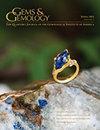History of Emerald Mining in the Habachtal Deposit of Austria, Part I
IF 1.6
3区 地球科学
Q2 MINERALOGY
引用次数: 0
Abstract
eighteenth Samuel Goldschmidt, followed English 1895. The sources of emeralds used in Roman jewelry as well as jeweled pieces (including crowns and book covers) dating from antiquity to the Middle Ages and before the discovery of the Colombian emerald deposits in the sixteenth century remain an ongoing matter of controversy. Two potential localities dominate the discussion: the mines in the Eastern Desert of Egypt and the Habachtal deposit in Austria. The first published reference to the Habachtal emerald occurrence dates to 1797. The majority of publications from the nineteenth and twentieth centuries agree that Samuel Goldschmidt, a jeweler from Vienna, purchased the mountain area in which the Habachtal emerald occurrence is located and commenced mining soon thereafter, in the early 1860s. A later period from the mid-1890s to about 1914 is frequently mentioned, in which the mine was owned and worked by an English company. However, further details regarding both periods and the various transitions of ownership and further circumstances of emerald mining before World War I are rarely given and often are not consistent, and activities in the times before the 1860s and between 1870 and 1890 are obscure. Using a wide selection of materials from Austrian and German archives, largely unpublished, the author seeks to trace the history of the Habachtal mine through several centuries and to fill gaps left by existing publications.奥地利Habachtal矿床翡翠开采史(上)
第十八塞缪尔·戈德施密特,1895年追随英国。罗马珠宝中使用的祖母绿以及从古代到中世纪以及在16世纪发现哥伦比亚祖母绿矿床之前的珠宝(包括王冠和书籍封面)的来源仍然存在争议。两个潜在的地点主导了讨论:埃及东部沙漠的矿山和奥地利的Habachtal矿床。第一次公开提及Habachtal祖母绿的出现可以追溯到1797年。十九世纪和二十世纪的大多数出版物都认为,维也纳的珠宝商Samuel Goldschmidt购买了Habachtal祖母绿产地所在的山区,并于19世纪60年代初开始开采。从19世纪90年代中期到1914年左右的后期经常被提及,当时该矿由一家英国公司拥有和经营。然而,关于第一次世界大战前祖母绿开采的这两个时期、所有权的各种转变和进一步情况的更多细节很少给出,而且往往不一致,19世纪60年代之前和1870年至1890年之间的活动也不清楚。作者利用奥地利和德国档案中大量未出版的材料,试图追溯Habachtal矿几个世纪的历史,并填补现有出版物留下的空白。
本文章由计算机程序翻译,如有差异,请以英文原文为准。
求助全文
约1分钟内获得全文
求助全文
来源期刊

Gems & Gemology
地学-矿物学
CiteScore
2.90
自引率
19.20%
发文量
10
期刊介绍:
G&G publishes original articles on gem materials and research in gemology and related fields. Manuscript topics include, but are not limited to:
Laboratory or field research;
Comprehensive reviews of important topics in the field;
Synthetics, imitations, and treatments;
Trade issues;
Recent discoveries or developments in gemology and related fields (e.g., new instruments or identification techniques, gem minerals for the collector, and lapidary techniques);
Descriptions of notable gem materials and localities;
Jewelry manufacturing arts, historical jewelry, and museum exhibits.
 求助内容:
求助内容: 应助结果提醒方式:
应助结果提醒方式:


